Our New Paper: Discovery of Nearby Young Brown Dwarf Disk!
We recently had another article accepted for publication in the Astronomical Journal! A pre-print is now available here. This paper presents the discovery a nearby young brown dwarf with a disk, W1200-7845.
Brown dwarfs are substellar objects that range in mass from about 13-80 Jupiter masses. They don’t have enough mass to sustain hydrogen burning in their cores, so they don’t qualify as stars, but they are just massive enough to burn molecular hydrogen (H2) in their cores, making them also distinct from planets. Understanding brown dwarfs is therefore key to understanding the connection between stars and planets. However, we still don’t know if brown dwarfs form the way stars do (gravitational collapse of a molecular cloud) or the way planets do (forming in the disks of larger stars and then getting ejected from orbit). Research on this is ongoing.
Identifying the Brown Dwarf
We first picked out W1200-7845 after classification on the Disk Detective website by estimating the effective temperature and the fractional infrared luminosity of the system, using fits to the system’s SED. The fractional infrared luminosity measures the amount of light in the object’s infrared excess as a fraction of the host’s light–a larger fractional infrared luminosity suggests an object with a significant amount of warm gas and dust around it. W1200-7845 has a fairly high fractional infrared luminosity but a low effective temperature, making an interesting object for further study.
We then cross-matched W1200-7845 with BANYAN Σ, a tool to estimate the likelihood that an object in in a young moving group based on its position, proper motion, and (if available) parallax and radial velocity. BANYAN Σ found that W1200-7845 had a 99.8% probability of being a member of the 3.7 million-year-old ε Chamaeleontis (ε Cha) association. Its Gaia DR2 parallax puts W1200-7845 at a distance of 102 parsecs or 333 lightyears, which is within the Solar neighborhood.
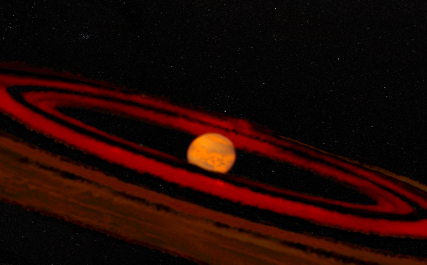
W1200-7845 Has a Circumstellar Disk
After confirming that W1200-7845 is a member of ε Cha, we moved on to better characterizing the host’s mass and effective temperature and classifying the circumstellar disk. To estimate the mass of W1200-7845, we plotted its SED, as shown below. Using W1200-7845’s SED, we fit the observed data (grey points) with a model for both the source (the brown dwarf itself) and its circumstellar disk. We found the best fit model for the source to be a substellar object with a mass of 42 Jupiter masses and an effective temperature of 2784 K.
We used three different disk models to find the best fit to the disk. We first tried a single blackbody fit (a disk with one approximate temperature and one fractional infrared luminosity). We then tried a power-law disk fit (the disk has a temperature gradient, with the inner material hotter). We finally tried a two-blackbody fit, meaning two disk temperatures for the inner and outer portions of the disk. We found that the best model was the power-law disk fit, which had a negative slope of -0.94. This value of the slope makes the disk a Class II YSO, common for young objects.

W1200-7845’s Near Infrared Spectrum
We also obtained a near infrared spectrum for W1200-7845 using the Magellan 6.5-meter telescopes at Las Campanas Observatory. We compared W1200-7845 to young brown dwarf spectral templates in order to find the best match. We found that the best match to W1200-7845 was a M6.0γ ± 0.5 spectral type, as shown in the spectrum below. This further confirmed that W1200-7845 is consistent with other young brown dwarfs. We weren’t able to resolve any signatures of accretion of disk material onto the host. However, accretion levels for brown dwarfs are very low due to their low mass, so it’s possible that the signatures of accretion are too low to be detected in our spectrum.
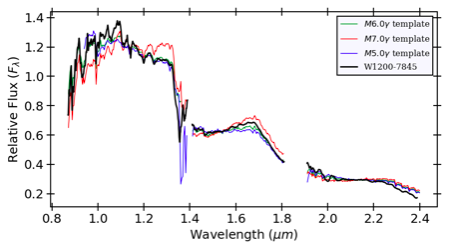
Why W1200-7845 Is Interesting
Objects like W1200-7845 are important because of their youth and proximity. Youth is important because we need to look at young objects at various ages to determine whether brown dwarfs form more like planets or stars. Proximity is important because brown dwarfs are inherently faint due to their low mass, so the closer these objects are the more detail we will be able to see. As W1200-7845 is both very young at ~3.7 million years old and nearby at 102 parsecs, it can serve as a benchmark object for future studies of brown dwarf formation and evolution.
What’s next?
Our next steps for W1200-7845 are to obtain longer millimeter observations in order to measure the mass of the disk, the disk’s radius, and to search for a cold dust component to the disk. Because W1200-7845 is so nearby, it is possible to resolve the disk to within a few AU (astronomical units) using larger radio interferometers like ALMA. This would allow for an unprecedented look at a key point in the evolution of brown dwarf disks. Obtaining an optical spectrum of W1200-7845 would allow for a more robust determination of the accretion level as the most prominent accretion line for brown dwarfs is Hα at .6563 microns.
We have also launched Disk Detective 2.0 to work on finding more objects like this! We have 143,000 more objects to classify! Check us out at diskdetective.org and on Twitter.
Welcome to Disk Detective v2.0!
Hi, all:
As you may have seen over the past month, or from today’s email blast from Zooniverse, Disk Detective v2.0 is LIVE!!!!!
Here’s a rundown of some of the things you may notice are different now:
- We’ve moved onto the Zooniverse Project Builder. This means that it’s much easier for us to change out image sets as necessary (e.g. adding on objects that receive Gaia parallaxes), and it’s easier for us to update the project otherwise.
- Instead of using SDSS and DSS2, we’re using PanSTARRS and Skymapper for our images at visible wavelengths. These surveys have higher spatial resolution and probe deeper than SDSS and DSS2 do, so we’ll be able to see fainter background objects and multiple objects that are very close together.
- Instead of the AllWISE images, we’re using image coadds from unWISE. These images (which are also used to assemble the data for Backyard Worlds: Planet Nine) have better spatial resolution than the AllWISE atlas, which will let us detect background objects more easily in the WISE data. However, this data set comes with its own unique set of issues, which I’ll discuss below.
- We’ve added a new circle in the images. Much like the red circle in DDv1.0 (and the outer circle in DDv2.0) correspond to the W4 point spread function (PSF; how light spreads out on the camera chip), this circle corresponds to the 2MASS PSF. This lets us know if our 2MASS data has multiple objects blended together, which could indicate interesting phenomena like a binary system!
- We’ve added a new option for classification: “multiple objects in the inner circle.” This is to indicate that the 2MASS and WISE photometry data will have two stars blended within it, which could affect our detection of a disk.
As part of this, today we deployed a new subject set. This set has the same objects as the previous set, but with improved image processing of the unWISE images to correct for saturation of the chip. We will be using classifications from the previous data set, but thought it was important to get the improved processing uploaded as soon as possible.
Please try out DDv2.0 and tell us what you think! If you have feedback on things that need clarification, feel free to reach out to us on Talk. And keep following us here, and on Twitter and Facebook for updates on the project!
Our New Paper: “Peter Pan Disks”!
We recently had another article accepted for publication in the Astrophysical Journal! A pre-print is now available on arXiv. This one presents four new identifications of long-lived accretion disks around M dwarfs (like the object in our second paper), presents new data on the first one we identified, and uses these data to define a class of “Peter Pan” disk.
In 1904, J.M. Barrie wrote the play (and book) “Peter Pan, or The Boy Who Wouldn’t Grow Up,” about a boy Peter Pan who stayed the same age forever. It was later adapted into a stage musical and a Disney animated movie. Here, we use the term “Peter Pan” disk to describe disks that behave like planet-forming disks (they have lots of material, and are still accreting material from the disk on to the host star), but are 5-10 times older than the typical planet-forming disk; they seem to “never grow up.”
New Peter Pan Disks
To identify new disks, we cross-matched the Disk Detective catalog with the second data release from the European Space Agency’s Gaia mission, which is working to determine accurate distances to the nearest billion stars to the Earth. We then ran the cross-match through BANYAN Σ, a tool that uses Bayesian probability to estimate the likelihood that an object is in a young moving group based on its position, proper motion, and (if available) parallax and radial velocity. This turned up several matches, but two were of particular interest: AWI00063nx (J0949), and AWI000601p (J0446), which were apparent M dwarfs with strong excess in the Columba and Carina associations, just like the Paper 2 object. When we looked at the Gaia data, we found that each one was an apparent visual double–there was a second star so close by that we couldn’t detect it in our data! The systems still showed excess even after taking both components into account, as seen in the SED plots below.
We observed all four stars with the GMOS instrument on Gemini-South to determine their spectral type, estimate their radial velocities, and see if we found any spectroscopic indications of youth and/or accretion activity. We found that all four targets were M-dwarfs; the two components of J0446 were both M6 stars, while J0949 is made up of an M4 and and M5. All of them show broad emission from the hydrogen spectral line at 656.3 nm, indicating accretion; J0949A also shows emission from the helium line at 668.3 nm, an additional accretion indicator. The spectra also show evidence of low surface gravity in the stars, an indicator of youth. Finally, the radial velocities we estimate from the data are consistent with moving group membership. Based on all evidence, these objects are young moving group members with disks.

The spectra of the four new Peter Pan disks. All four are M dwarfs. The large dips are due to gaps in the camera chip on the spectrograph. Note the strong emission of the hydrogen H-alpha line at 6563 angstroms.
Characterizing Known Peter Pan Disks
In addition to identifying new disks, we also took more observations of the Peter Pan disks we already knew about. We analyzed light curves of J0808 (the Paper 2 object) with the 0.9-meter telescope at Cerro Tololo Inter-american Observatory (discussed in this blog post), and light curves of J0808 and J0501 (a published Peter Pan disk) from the Transiting Exoplanet Survey Satellite (TESS). From the light curves of J0808, we identified one bright flare, and noticed light curve variations that could be disk material blocking the light of the star.
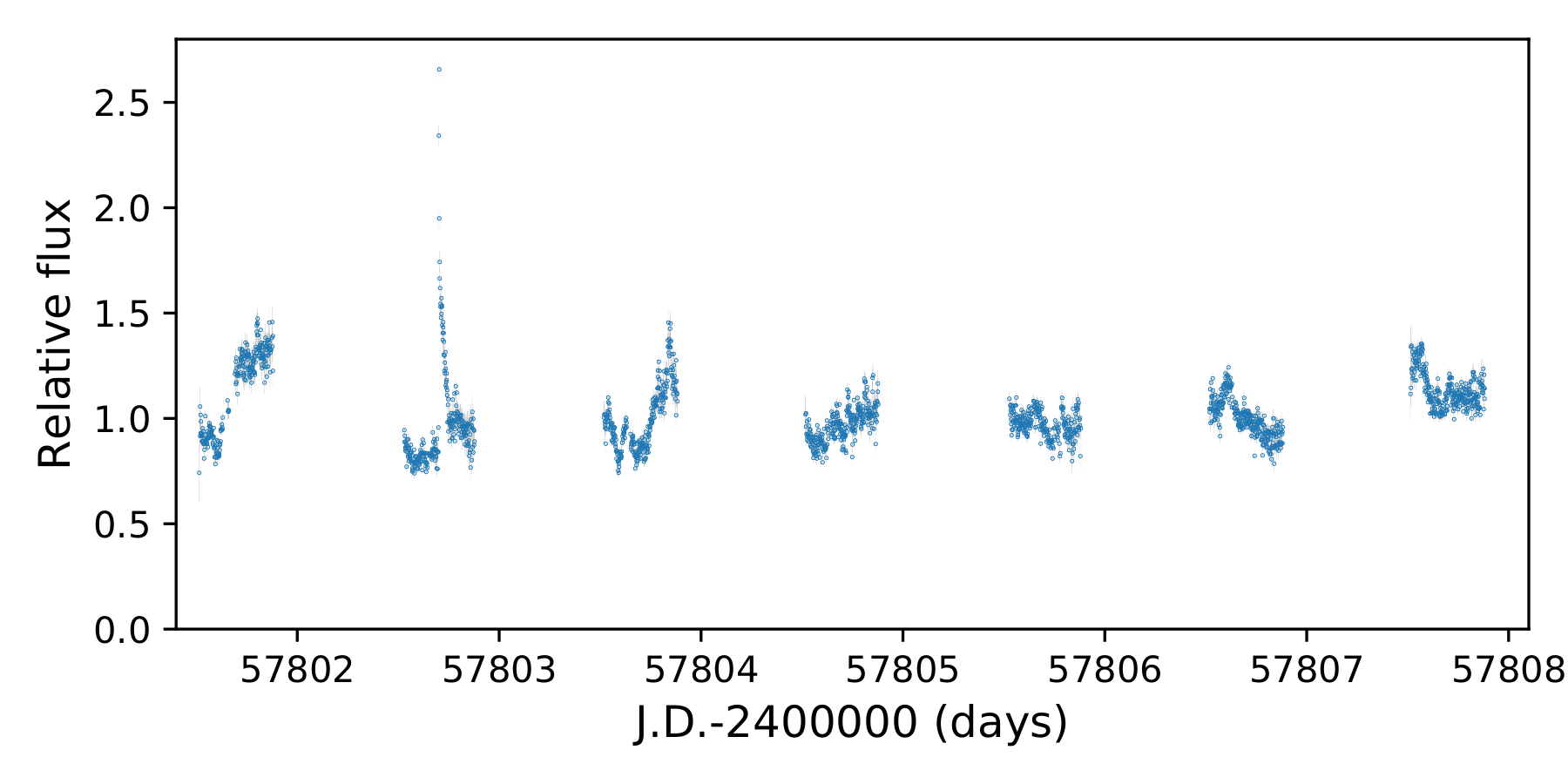
The CTIO light curve of J0808. Note the flare in the second night of data displayed.
In the TESS light curve of J0501, we saw clear periodic variations that closely follow the expected behavior for a persistent starspot or complex of starspots–like appear on our Sun, but covering more of the surface! While we didn’t see any disk occultations, we also detected a clear flare, and from published spectra and the period of the variations, we were able to determine that the system is inclined to our line of sight by ~38 degrees–enough that we wouldn’t expect the disk to go between us and the star.

The light curve for J0501 from TESS. It shows clear sinusoidal behavior, and a flare at around Day 1431.
We also observed near-infrared spectra of J0808 from CTIO, as part of our M dwarf follow-up observations. We found that the spectrum varied on 24-hour timescales. Specifically, we saw variations in the Paschen-β and Brackett-γ lines. Like the Hα line discussed above, these are hydrogen spectral lines that trace accretion activity, but unlike Hα, they aren’t as affected by stellar activity (e.g. flares). These variations show clear evidence of accretion.
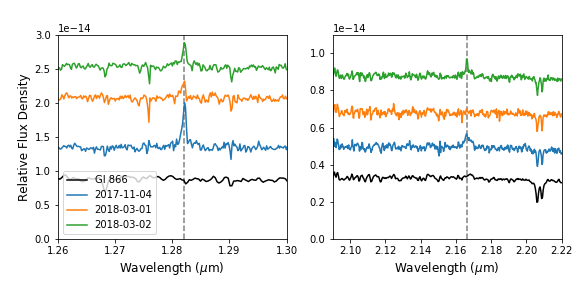
The Paschen-β and Brackett-γ lines of J0808 across three nights, with a non-accreting template for comparison. There are clear changes to the lines across each night.
What Makes a Peter Pan Disk?
What Makes a Peter Pan Disk? Using the characteristics we observed above, we found the following criteria:
- M-type or later spectral type star or brown dwarf
- With a Ks-W4 color >2, indicating a substantial warm disk
- At age >20 Myr
- With spectroscopic evidence of accretion.
Thus far, including the new objects presented here, there are seven Peter Pan disks known. While one of these might be an outlier, seven suggests a class of disk instead.
Why do these occur? There are several possibilities discussed in the paper; however, the most likely is simply that primordial disks around M dwarfs take longer to dissipate than their higher-mass counterparts, a trend observed in younger associations (e.g. the fraction of primordial disks is higher around M dwarfs than earlier-type stars in the Upper Scorpius association). This would mean that the timescale for planet formation around M dwarfs is longer than we previously thought, which could significantly affect the conditions of planetary atmospheres on these planets.
Next Steps
Our next steps are to characterize the known Peter Pan disks, and find more. We won time with the Chandra X-Ray Observatory to find X-ray fluxes for the known systems, which will give us information on the photoevaporation rates of these systems–it will tell us how quickly the stars’ energy evaporates disk material. We will also be doing some follow-up with the Magellan telescopes in Chile this June.
And we’ll be relaunching Disk Detective this year! We’ll be slightly changing the qualifications for including objects, with the goals of finding more Peter Pan disks. We’ll also be using the Zooniverse Project Builder interface, which will make tweaking the project over time easier. Look for a relaunch announcement in a few months!
The Disk Detective Database
We have a database! Thanks to a grant from the Space Telescope Science Institute, much of the Disk Detective science product is now available through the MAST archive.
What you’ll find there:
- Information on the classification data of individual objects from Disk Detective;
- Additional review information (literature review; more detailed examination) provided by members of the Disk Detective team;
- Cross-matches with Gaia, Pan-STARRS DR1, the TESS Input Catalog, and the APASS DR9 Catalog;
- Basic blackbody model SED fits to the observed data, with best-fit stellar effective temperature, disk temperature, and fractional infrared luminosity;
- Analysis of subjects from a convolutional neural network trained on Disk Detective classification data.
For more details on the information contained in each column, see below.
Original Selection Criteria
The original selection criteria to be included in Disk Detective were as follows (from Disk Detective Paper 1):
- w1mpro > 3.5 — WISE1 magnitude >3.5
- w4mpro < (w1mpro – 0.25) — WISE4 excess of 0.25 magnitudes over W1
- w1mpro > 5*sqrt((w1sigmpro*w1sigmpro)+(w4sigmpro*w4sigmpro)) + w4mpro — The W4 excess is significant at the 5-σ level
- w4sigmpro is not null and w4rchi2 < 1.3 — W4 profile-fitting yielded a fit with χ-squared < 1.3
- w4snr >=10 — W4 profile-fit signal-to-noise ratio > 10
- w4nm > 5 — Source detected at W4 in at least 5 individual 8.8s exposures with SNR > 3
- na = 0 and nb = 1 — The profile-fitting did not require active deblending
- n_2mass = 1 — One and onely one 2MASS PSC entries found within a 3″ radius of the W1 source position
- cc_flags[1] not matches “[DHOP]” and cc_flags[4] not matches “[DHOP]” — No diffraction spike, persistence, halo, or optical ghost issues at W1 or W4
- xscprox is null or xscprox > 30 — No 2MASS XSC source <30″ from the WISE source
- ext_flg = 0 — Photometry not contaminated by known 2MASS extended sources
Identifiers and Classification Data
The two primary identifiers used in the database are:
- designation: AllWISE ID
- ZooniverseID: unique ID for each target used in the Disk Detective back end
The raw classification data is broken into six categories, corresponding to the six options selectable by citizen scientists on the Disk Detective Web site. A screenshot of the classification page is shown below for reference.

- good – “None of the Above/Good candidate”
- multi – “Multiple objects in the Red Circle”
- shift – “Object Moves Off the Crosshairs”
- extended – “Extended beyond circle in WISE images”
- empty – “Empty circle in WISE images”
- oval – “Not round in DSS2 and 2MASS images”
There are two other relevant status columns:
- classifiers – number of times a citizen scientist clicked “Finish” on a subject
- state – status on the website as of April 30, 2019
In addition, there are several “Fraction” columns (goodFraction, multiFraction, etc.). These are simply the number of votes in a category, divided by the number of classifiers for that object. So goodFraction = (good)/(classifiers), etc.
Vetting and literature review
In addition to classifications, we have a detailed literature review and re-evaluation by the team. The information from these is stored in three columns:
- flags – Objects flagged as having certain characteristics
- SciTeamFollowUp: whether or not we think the object is worth following up
- SciTeamComment: detailed comments explaining the decision in SciTeamFollowUp, including other literature references
Machine learning
Using Disk Detective classification data as a training set, we constructed a convolutional neural network to analyze Disk Detective images. The most useful results from this are listed in the “majGood” column.
- majGood: quality rating from a neural network trained on Disk Detective data.
Cross-matches
There are several cross-matches from Disk Detective to other surveys. These columns are generally denoted by a lower-case letter before the column name from that survey. We list these surveys below to demonstrate what prefix corresponds to which survey.
- pXXXXXX = data from PanSTARRS DR1
- gXXXXXX = data from Gaia DR2
- tXXXXXX = data from the TESS Input Catalog
- aXXXXXX = data from the AAVSO Photometric All-Sky Survey.
SED fits
SED fits for all objects are calculated using a maximum-likelihood estimator, using SciPy’s built-in minimize function from the optimize package. These SED fits take in as inputs the Gaia, 2MASS, and WISE photometry, and fit two blackbodies to the data, one each for the star and disk. For objects with more than two points of excess, a power-law fit is also calculated.
To view the SED for an object, click the thumbnail image in the row for that object in your search.
Results from these fits are also listed in columns.
- Tstar: best-fit blackbody stellar temperature
- Tdisk: best-fit blackbody disk temperature
- lir_lstar: best-fit fractional infrared luminosity.
NOTE: These SEDs are provided solely as a first-look estimate, to determine if a disk model is physically feasible (helping discern e.g. a background AGN), and should be interpreted with caution. In particular, blackbody fits are non-ideal for stellar temperatures below ~4000 K.
Acknowledgements
We thank Bernie Shiao, Geoff Wallace, and Justin Ely for their contributions to producing this database at MAST. We thank David Rodriguez for his work in implementing the SED fitting algorithm. Finally, we thank the ~30,000 citizen scientists whose contributions examining images of these objects by eye make up the bulk of our science product. In particular, we recognize citizen scientist Hugo A. Durantini Luca for his time and effort in beta-testing the database for use by the Disk Detective team and the rest of the field.
Our Third Paper: The Advanced Users’ Story
By Katharina Doll, Johanna J.S. Finnemann, Hugo A. Durantini Luca, Joshua Hamilton, and Michiharu Hyogo
As Steven from the science team wrote in his blog post, our third paper has been accepted for publication. Nine citizen scientists from the advanced user team are listed as co-authors. Today we want to show you the work we did for this paper.
Our contributions for this paper fall into three parts: the image analysis of Robo-AO follow-up images, the classification of M dwarf debris disk candidates presented by Theissen and West (2014), and finding references related to our disk candidates.
1. Analysis of Robo-AO images
As already explained in the glossary and earlier in this blog, only objects with significant Infrared excess in WISE images are pre-selected to be classified. It is mainly because the circumstellar disks shine brightly in these spectrums. However, there is a major problem: several close-together objects can blend together in infrared, making it look like the sort of infrared excess the disks we are searching for exhibit.. Moreover, there are other astronomical objects which also shine brightly in Infrared spectrum of light such as background stars (located nearby) or much further away, galaxies, interstellar gas and dusts, and AGNs/QSOs outside our own galaxy. The Robo-AO and Dupont telescopes have a better resolution than the flipbooks shown on the classification interface, so we’re able to see contaminating objects that don’t show up when you classify on the main site (and therefore submit something as a “good candidate”).
We learned how to work with software (DS9, which professional astronomers also use) to look at the files from the telescopes and determine any contaminants. We’ll show you several sample images that we used:
Case 1 Close by Background Objects

Example image of a disk candidate with a close-by background object.
Here is an example image of an object (Zoo ID AWI0000kk6) with a bright object located very close by. It needed follow-up observing because it is already known as a binary system (and had been flagged in the Talk comments).
Case2: Faint Fuzzy object

Example of a disk candidate with a faint, fuzzy background object.
Another example image (Zoo ID AWI000028h) with a faint fuzzy object located in the corner of the image. This object (located at 11 o’clock from the main target) is likely an extragalactic object like a galaxy or an AGN.
Case 3: Good object in Follow-up Images

Example of a good object with no apparent contamination or confusion.
2. Classification of disk candidates published by Theissen & West (2014)
As Steven explained in his blog post on the paper, members of the advanced user team looked at previously published disk candidates by Theissen & West (2014). Using their WISE IDs, we used the IRSA Finder Chart tool to generate images in the same wavelengths as in the flipbooks on the main site (SDSS, DSS, 2MASS, WISE). Joshua Hamilton added red circles on all images so that we could use the same method on these objects as we do on normal Disk Detective objects.

Theissen & West’s disk candidates found in the IRSA Finder Chart. Red circles displayed were added by a super user, Joshua Hamilton.
We found out that most of the disk candidates from Theissen & West (2014) disk candidates are not present in Disk Detective because they have a low signal-to-noise ratio in WISE 4 (the last image you see in a flipbook), and in addition most are contaminated in our criteria. For example, all were extended in W4 images and thirteen of them consists of multiples.
As you can see in the example above, more than one object is visible in SDSS images, and the bright blue fuzzy objects extend outside the red circle in WISE images . Hence we concluded this object does not satisfy our criteria of our classification process.
3. Finding references
Lastly, we contributed by finding references related to our disk candidates. About a week before the paper was first submitted, Marc Kuchner, the principal investigator, had asked the super users to look for any interesting references related to the disk candidates of this paper just in case. We used tools such as SIMBAD and VizieR (which Marc explained here and here on the blog) and searched information regarding each of those candidates. VizieR provides us with access to a number of astronomical catalogs. Each of these catalogs consists of a major survey mission and it includes astronomical information regarding the object such as distance(parallax), luminosity, and spectral type.
Let’s show you an example of how it was done. First we typed in coordinates for each candidate, in this case AWI00062lo, which is shown in one of the figures above.
In the figure, we see the coordinates of the candidate, AWI00062lo. After we enter this, we are able to see a number of astronomical catalogs related to this object.
In this figure below, you can see a part of the VizieR site that shows two catalogs inside blue circles.

Example of how catalogs are displayed within VizieR.
Two catalogs shown are Gaia DR2 and FON Astrographic Catalog. One of these catalogs, Gaia DR2, is especially important because this survey mission measured positions and distances of 1 billion stars with unprecedented precision. The parallax value which determines the distance of a star is provided by Gaia (8.8526 milli-arcseconds = 112.9 parsecs in this case).
Through this simple process, we found a significant catalog in VizieR, Oh et al. (2017), which contains data on some of our candidates including AWI00062lo. In the Oh et al. (2016) survey, new comoving pairs are searched in the Tycho-Gaia solution.
This has assisted us to compare our results with Oh et al. (2017): For example, only 1.37% of stars in Oh et al. (2017) are members of comoving pairs while 11% of our candidates are in such pairs. These results support the hypothesis of Zuckerman (2015) which stated that there is a high frequency of warm debris disks exist within binary systems of young stars. We also cross-checked with other reference catalogs on VizieR.
4. Who are we?
Finally, a brief look at who we are and what we do in our daily lives.
Joshua – I am from the mid-Michigan area where I work as the Director of Youth Ministry at a large Catholic parish. I have a degree in Media and Information from Michigan State University, which inadvertently came in very handy for this paper. What I love most about Disk Detective is that someone like me, with very little professional training in astronomy, can collaborate on incredible scientific research with people from around the world. Though we are all different, we all share on thing in common: our love of discovery and science. For this paper, I used my design software skills to build a precise overlay for the Theissen and West Paper images that we wanted to study. I took 175 Theissen and West images that they had classified as good disk candidates and overlaid the red circle that you’d normally see when classifying on the Disk Detective website. This allowed us to analyze their images just we do our own and by doing this analysis, we found that many of the “good candidate” disks from their paper were contaminated by multiple objects within the red circles.
Hugo – I am from Cordoba, province of Cordoba, Argentina. Computer technician and a few other things. Aside of citizen scientist now I’m part of the GAF (Grupo de Astrometría y Fotometría / Astrometry and Photometry Group) of Cordoba. My years of experience working with computers were always handy to work with Disk Detective and when we started to work in this paper that was not exception. Several of my experiences with Disk Detective are captured in our blog, but it’s fantastic the range of experience what the projects ended making possible for me. If have the answer the questions about what I do for the project, I think what the best answer is “a bit of everything” since I help with things what can range from website classifications, vetting or literature checking to recording and uploading the hangouts videos, managing the Spanish Disk Detective twitter account and side projects.
The image analysis with DS9 was my first time using that software. The learning curve for the analysis was a bit steep but not difficult. I think that the image analysis with DS9 was the first analysis done for paper 3 or at least one of the first biggest part what we as superusers worked on. I remember how we learned to differentiate between real objects and fake signals in the images, fun process what included sometimes using the rainbow color scheme in DS9 that changes black for fluorescent pink, great for contrast, not so great for the eyes.
I also ended in charge of putting together and organizing the spreadsheets where the superuser group was putting their conclusions in the different batch of objects. If some old notes are correct, in some point also helped downloading and uploading again the batch of objects in smaller chunks to help other users with slower internet connections. Making the notes to learn the difference between ghost and real objects was interesting. Some artifacts were easy to tell apart from real objects, but others not so much. Discussing our findings, doubts and ways to work with DS9 was a great experience overall.
Michiharu – I am from Tokyo, only super user from Japan. I have lived outside my country for more than two decades. I have completed masters degree in Astronomy 8 years ago while I was in Australia. I also have completed another masters degree in Information Technology. I am currently looking for a physics lecturer position in one of the universities in Tokyo. Although the Disk Detective project is not quite related to a research topic I studied while completing masters degree, I have basic knowledge regarding astrophysics and therefore I have been able to learn science behind this project and how to contribute very quickly without major problems. My main tasks for this project are a normal classifications of DSS, 2MASS, and WISE images, and vetting of those objects classified as good objects in the classification stage, which includes literature reviews, to help further select sample targets for the observations. On top of all these tasks, I worked on image analysis on the ROBO-AO images with several other super users using the DS9 imaging software to look for possible contaminants, for this paper.
Katharina – I am from the greater Munich, Bavaria region in Germany and currently work as a research assistant in legal history at university. I have degrees in law and business studies. Being a member of the advanced user group is therefore a great opportunity for me to contribute to a completely different field of research! For this paper, I worked on vetting objects classified as good objects and on analysing Robo-AO images for background contaminants using DS9.
Johanna – A cognitive neuroscientist by training, my passion for science has always extended beyond my primary research area. I believe that while boundaries that mark off one field of science from another can of course be useful, they remain artificial constructs and can also get in the way of connecting people and ideas. It’s for that reason that I’ve enjoyed becoming a member of the Disk Detective team; it is an extraordinary opportunity to make meaningful contributions to an area of science without the formal training/qualifications that are so often indispensable. I’ve learned a lot and not just about astronomy but also about serious involvement of the public in science (something my field is still struggling with!) and I hope that I can in turn also use my experience in data science and understanding human cognition and perception to advance the project.
My involvement in this paper (the vetting of the Theissen & West images) was one of the first things I did after joining the advanced user team and it was great to feel involved right from the start – even while I was still finding my feet. Deciding on analysis pipelines to improve the false positives/false negatives is once again a much broader scientific issue and so it was interesting to apply it to our specific problem in identifying the pitfalls of certain classification criteria.
Lily – I am from Singapore. I graduated with a bachelor’s degree in Library and Information Studies. Apart from being a citizen scientist, I am also an amateur photographer. My astronomy journey started in 2003, I have enrolled in a couple of online astronomy courses as well as taking part in several online citizen science projects. When Disk Detective launched in 2014, I quickly registered. Throughout my time with DD, I have participated in several of its projects; ROBO-AO Imaging of Debris Disks was one of them. My task was to identify possible companion objects and artifacts to a nearby debris disk candidate, and record their locations. I am honored to be part of the team. The knowledge that I have gained from the project is invaluable.
Do you want to join us? If you’ve done 300 classifications and you’d like to get more involved in our next paper, drop us a line at diskdetectives@gmail.com and ask to join the advanced user group.
Our New Paper is Out!
Good news, everyone: our latest paper from Disk Detective has just been accepted for publication in the Astrophysical Journal! You can read it on the arXiv now. In it, we estimate the number of disks we expect to find in Disk Detective, and present over two hundred new disk candidates that have received high-resolution follow-up imaging.
Disk Detective is designed to identify new disk candidates in the AllWISE catalog by eliminating false positives. Because we have such a large catalog and so many classifications that have been made so far (keep them coming!), we can get some statistics on how many objects are false positives, and use that to estimate the number of disks we expect to find. We can also break this down by what kind of false positive we find, and where in the galaxy we find it.
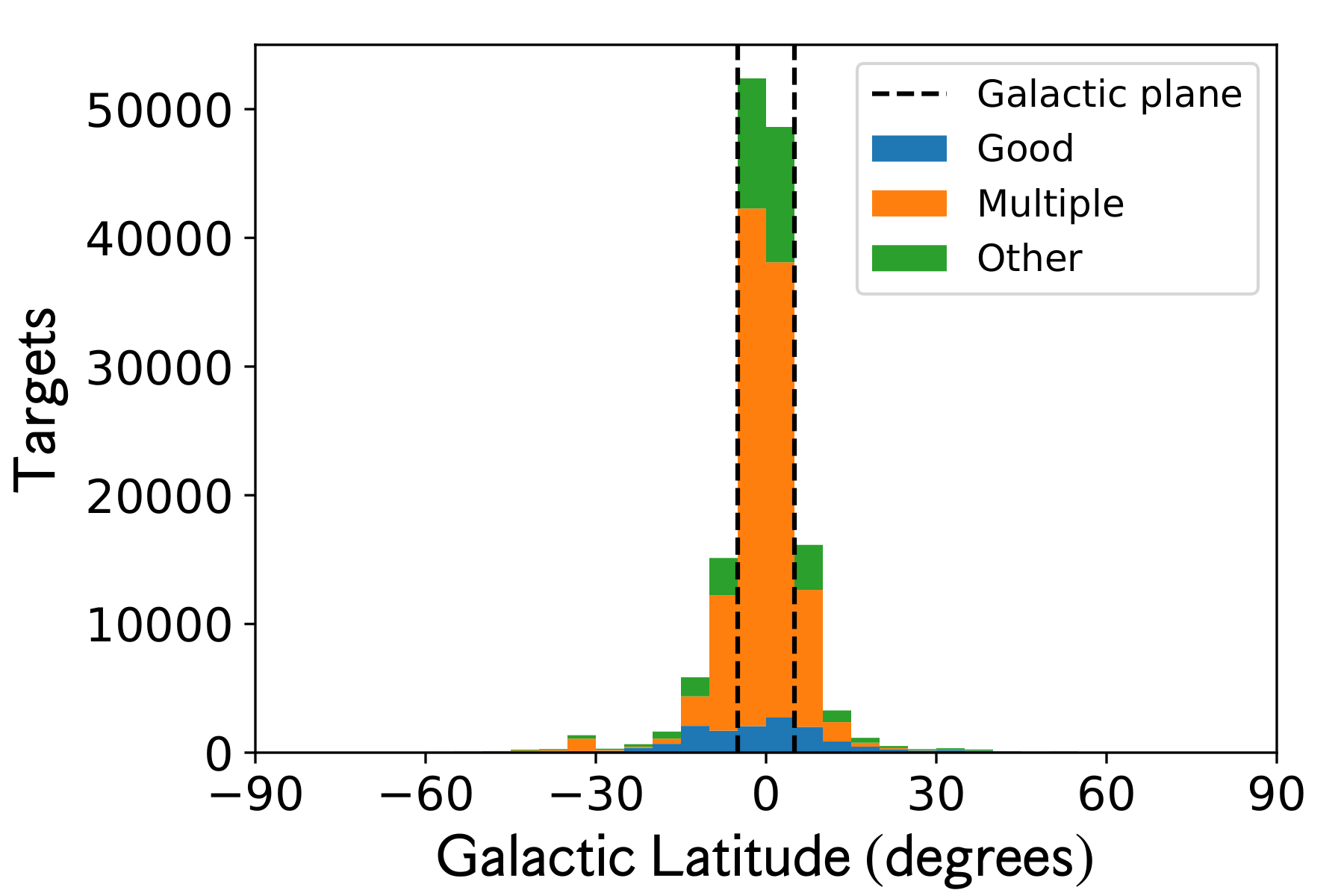
Objects as a function of Galactic latitude. Most objects are in the Galactic plane, and most of those objects are multiples.
In general, “multiples,” objects for which a majority of classifiers clicked “Multiple objects in the Red Circle,” are the most common type of object–more than 70% of the objects in the catalog! Only about 8% of objects are classified as “None of the Above/Good candidate” by a majority of classifiers. These occur most often in the Galactic plane, as you’d expect–if there’s more stars in the Galactic plane, you’d expect to get more disk candidates there. However, multiples become much more common in the Galactic plane, as well–the multiple fraction in the Galactic plane is over 70%!
We looked to see the multiple fraction (the fraction of objects in a given range that were multiples) as a function of Galactic latitude. We expected that these would be most common in the Galactic plane, and fall off as you got further away from it. We found instead that while for the most part this is the case, there’s an additional peak between -30 and -35 degrees Galactic latitude.
So we looked at the multiple fraction as a function of both Galactic latitude and longitude, as shown on this heatmap (brighter = higher multiple fraction), and found that most of those multiples outside the Galactic plane occurred at the same Galactic latitude as the Large Magellanic Cloud–we have multiples caused by stars in nearby dwarf galaxies, too.
In addition to the website classifications, we also review our objects in the literature to ensure that we’re not identifying things that are known to be non-disk sources (like background galaxies). This eliminates an additional 14% of our objects, the remainder of which becomes DDOIs.

Objects with high-resolution follow-up as a function of Galactic latitude. Unlike with the website classification data, there’s no significant difference between in and out of the Galactic plane.
We took high-resolution images of 261 of our DDOIs to see if we could identify faint background objects, fainter than would be detectable in our survey data but bright enough to produce a false positive at W4, using the Robo-AO instrument while it was at Palomar, and RetroCam on the Irenee R. Dupont telescope at Las Campanas Observatory in Chile. (I wrote about my observing experience at LCO here.) We included some volunteers from our advanced user team in the analysis of this data–they’ll have a blog post up on the details of what they did soon. Overall, we found that 244 of the 261 objects were good disk candidates once faint background objects were taken into account.
Combining all of these, we estimate that only 7.9% of all infrared excess candidates in AllWISE are or will be good disk candidates. That means that we expect to find 21,600 disks in AllWISE, almost double our original estimate!

Estimated false positive fraction for several surveys. Surveys that visually inspect the data (blue) have lower expected false positive rates than surveys that don’t (orange).
We were able to use our false positive rates to estimate how many false positives appear in published disk searches. Many surveys do a good job, but have some false positives due to objects only detectable in high-resolution imaging. Some larger searches, however, seems to be riddled with false positives, including the McDonald et al. (2014) and (2017) searches, and the Marton et al. (2016) search. These searches don’t include a visual inspection of the images, and thus are likely to have high rates of false positives due to multiples at the minimum.
We were also able to leverage the knowledge base of our Disk Detectives to analyze the M dwarf disk candidates of Theissen & West (2014). M dwarf disks are key targets, because very few have been found, despite the abundance of M dwarfs nearby. The advanced user team got together and found a way to analyze the targets as if they were Disk Detective objects (more on this in their blog post coming soon). We found that only 13 of the candidates from Theissen & West (2014) had high enough signal-to-noise for the Disk Detective methodology to apply. Advanced users found flaws with all thirteen, making all of them false positives.

An HR diagram of our candidates with parallaxes from Gaia. Color of each point indicates the disk temperature, while size of each point indicates the strength of the infrared excess. This plot shows that while most of our objects lie on the main sequence (like our Sun does), many others lie off of it. We think that most of the ones off the main sequence are primordial disks.
Finally, we presented a list of 244 disk candidates with follow-up high-resolution imaging, 213 of which are new discoveries by Disk Detective. These seem to be split evenly among debris and YSO disks, though some of those YSO disks could potentially be “extreme” debris disks, which are thought to result from collisions of terrestrial planets. We made some further interesting discoveries among these:
- We found that twelve of our new disks were in comoving pairs (that is, another star nearby to them has similar motion), providing further support to the hypothesis that warm circumstellar dust is associated with binary systems.
- We made the first identification of 22-micron excess around two stars that are known to be in the Scorpius-Centaurus young association, and identified known disk host WISEA J164540.79-310226.6 as a likely member of Sco-Cen, based on its motion through the sky. By identifying these targets as members of Sco-Cen, we give them likely ages, letting us put these on timelines of disk evolution.
- We found thirty-one disk candidates within 125 pc, including 27 debris disks. These are good targets for both direct imaging exoplanet searches, and spatially resolving the disk itself in scattered light–making these targets optimal for observation with the James Webb Space Telescope.
And there’s still more work to be done! We recently hit 76% complete (that is, 76% of all our targets have enough classifications to be retired from the website), but that leaves more than 60,000 excesses to evaluate with your help. We now know how many objects we’re going to find–now it’s our job to finish finding them.
Gaia and Virtual Reality
Disk Detectives,
This spring we did a big classification push to prepare for the second data release from the Gaia mission, which arrived on April 25, providing distances to more than a billion stars. This data instantly converted a substantial fraction of our Disk Detective catalog from mystery objects into stars with known distances and spectral types. Thank you for all your help getting ready for this event! We’ve been hard at work since then on (at least) two projects involving Gaia Data Release 2 (DR 2) and Disk Detective data. And here to tell you about one of them is Susan Higashio, a masters student at International Space University who has been spending her summer as an internal at Goddard Space Flight Center, working on Disk Detective data in Goddard’s new Augmented Reality/Virtual Reality lab.
Best,
Marc

Susan Higashio, at Goddard’s AR/VR lab, exploring Disk Detective discoveries using Virtual Reality. Photo credit: Matt Brandt
__________________________________________________________
Greetings, Disk Detectives!
It’s Susan here and I’m thrilled to be a summer intern with Dr. Marc Kuchner on Disk Detective this summer! When I found out that I would be working at NASA Goddard, I was SUPER stoked; not only because it was NASA, but being from the West Coast of Canada, I was really looking forward to visiting the East Coast of America for the first time! Truth be told, I felt a little (A LOT!) intimidated being in the Astrophysics department here at NASA—especially because my background is NOT Astrophysics—but I quickly learned that one of the great things about citizen science is that with a little hard work and dedication, anyone can be a citizen scientist!

Positions of the Stars with Disks You Discovered: A Screen Shot from Goddard’s VR Lab.
Thanks to all you Disk Detectives for classifying all those stars with debris disks and accretion disks! Now, I’m working on a Virtual Reality (VR) project with these Disk Detective objects. They are loaded into VR with the Gaia DR2 Release, and the Disk Detective objects that you’ve classified light up in the VR system.
In addition to being great fun, VR is a really great way to see stars from different perspectives. When we evolve their positions backwards and forwards in time, the Disk Detective objects help reveal groups of stars that move together, or “young moving groups”! Stars within a moving group formed from the same event so they are about the same age, originate from the same area in space and move in the same direction at about the same speed. Many of the Disk Detective objects I am looking at are young, relatively speaking, (we’re talking tens of millions of years old, compared to our sun, which is about 4.56 billion years old) and so moving groups can be studied to learn about how our solar system may have formed and evolved over time. There are many known moving groups (e.g., a list of young moving groups can be found here) and stars found in Gaia DR2 that we can see in VR might belong to a known group, or maybe even be part of a new one. Wouldn’t it be exciting if some Disk Detective stars made up a new moving group?
In the 6 weeks that I have been here, I have learned so many new things. I’ve learned how to make calculations to plot H-R diagrams with stellar isochrones, which are helpful to estimate the approximate age of objects, as well as position/proper motion vector diagrams which illustrate the movement of objects over time. These diagrams can be used to plot any interesting Disk Detective objects to see if they move together over time and possibly see if they might form a moving group. I have also been spending time in the VR lab to search for additional stars that move with together with some interesting Disk Detective objects that I have had my eye on. This is not as easy as it sounds!
It’s not all work here though! I’ve had the pleasure of meeting Disk Detective citizen scientists, Josh Hamilton and his wife, Sarah, when they came to visit NASA Goddard. Marc took us all, including Steven Silverberg and another citizen science intern Michaela Allen, on a tour of the integration and test facility. It was really cool that the James Webb Space Telescope had been in the clean room just months earlier and information about the telescope is still on display.
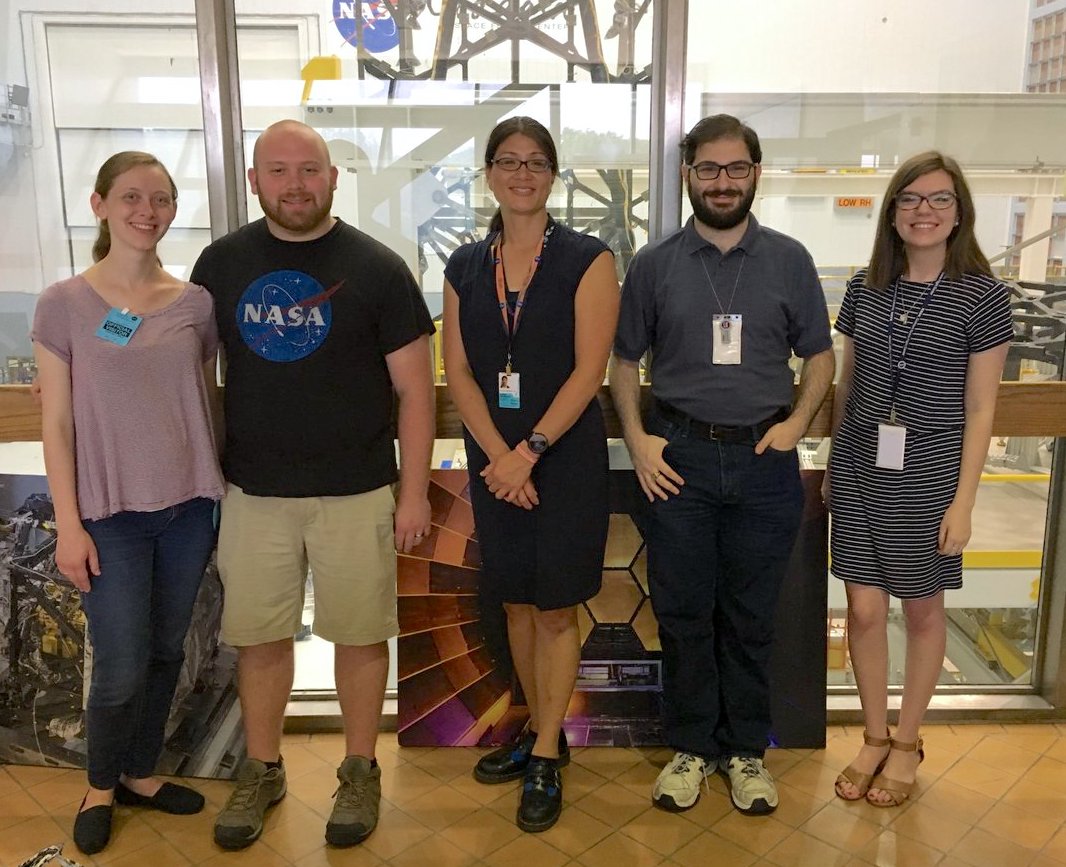
Disk Detective Citizen Scientists Josh and Sarah Hamilton (left) visiting the highbay at NASA Goddard Space Flight Center with Susan Higashio (middle), Steven Silverberg and Backyard Worlds: Planet 9 intern Michaela Allen (right). Photo credit: Marc Kuchner.
I have long dreamed of working at NASA, and because of Disk Detective and citizen science, this has been an unforgettable experience and a dream come true! Many thanks to Marc, without whose support and guidance I would not be here on this internship; to Professor Hugh Hill at ISU, who was formerly at NASA Goddard and who still has many friends here; as well as many other people who I have learned so much from during my stay here so far: Steven Silverberg and the Disk Detective team, Sarah Logsdon, Michaela Allen, and Peter Pokorny; along with the VR team: Matt Brandt, Tom Grubb, and interns Stewart Slocum, Tyler Cahill, and Hayden Hotham, to name a few. I am really looking forward to spending the rest of the summer here and continuing my work with Disk Detective and all of you citizen scientists. Thank you for your hard work and keep on classifying those objects!
-Sue
My Year In Astronomy, by Citizen Scientist Hugo Durantini Luca
Today we have a guest post from Disk Detective citizen scientist Hugo Durantini Luca., from Cordoba, Argentina, who just returned from another trip to the Complejo Astronómico El Leoncito (CASLEO) observatory to make follow-up observations of our disk candidates. I think Hugo is going to end up a professional astronomer if he keeps this up! –Marc
My Year in Astronomy
First of all, and to avoid repetitions, if you have not read my other post in this blog, you can take a look here: This post is a continuation of that experience, my love for Astronomy has only get bigger since back them.
2016 and 2017 have been a without a doubt a couple of interesting years for me regarding astronomy, but 2017 takes the prize in my opinion. Even if not in the way that I originally planned or imagined, a lot of the things that I thought back in 2015 started to take form.
While the work in Disk Detective was progressing, 2016 was dedicated to expanding my practical knowledge in Astronomy thanks to the different workshops of the Grupo de Astrometría y Fotometría / Astrometry and Photometry Group (GAF) at the Observatorio Astronómico Córdoba (OAC). I learned some basics about astronomical instruments and more advanced concepts about image processing to be able to make scientifically valuable reports of astrometry and photometry.

Town of Tolar Grande (Credit: Hugo Durantini Luca)
In 2017 the travel opportunities started to appear again and, of course, I tried to make the most of them, with two travels to CASLEO in the San Juan province for Disk Detective observations, one to the Observatorio Astronómico Tolar (OAT) in the Salta province, and a couple of good experiences in La Estación Astrofísica de Bosque Alegre (EABA) in my own province. Except for CASLEO, the rest were related to my participation in the GAF and IATE.
CASLEO feels after three trips like a very familiar places, so much that even after observing 100 stars this year alone for Disk Detective, I never get tired and always looks forward to return again. Plus, working along Luciano Garcia from the OAC is always a pleasure and a great learning experience. Without a doubt, working with spectrographs never ceases to be interesting.

CASLEO observatory in winter (credit: Hugo Durantini Luca)
This year I enjoyed the opportunity of exploring the landscapes of CASLEO in two different seasons of the year, and along the trip of 2015, now I have almost a complete picture almost complete of how they change throughout the year. What never changes is the enjoyable environment which welcomes our arrival—another reason to return.
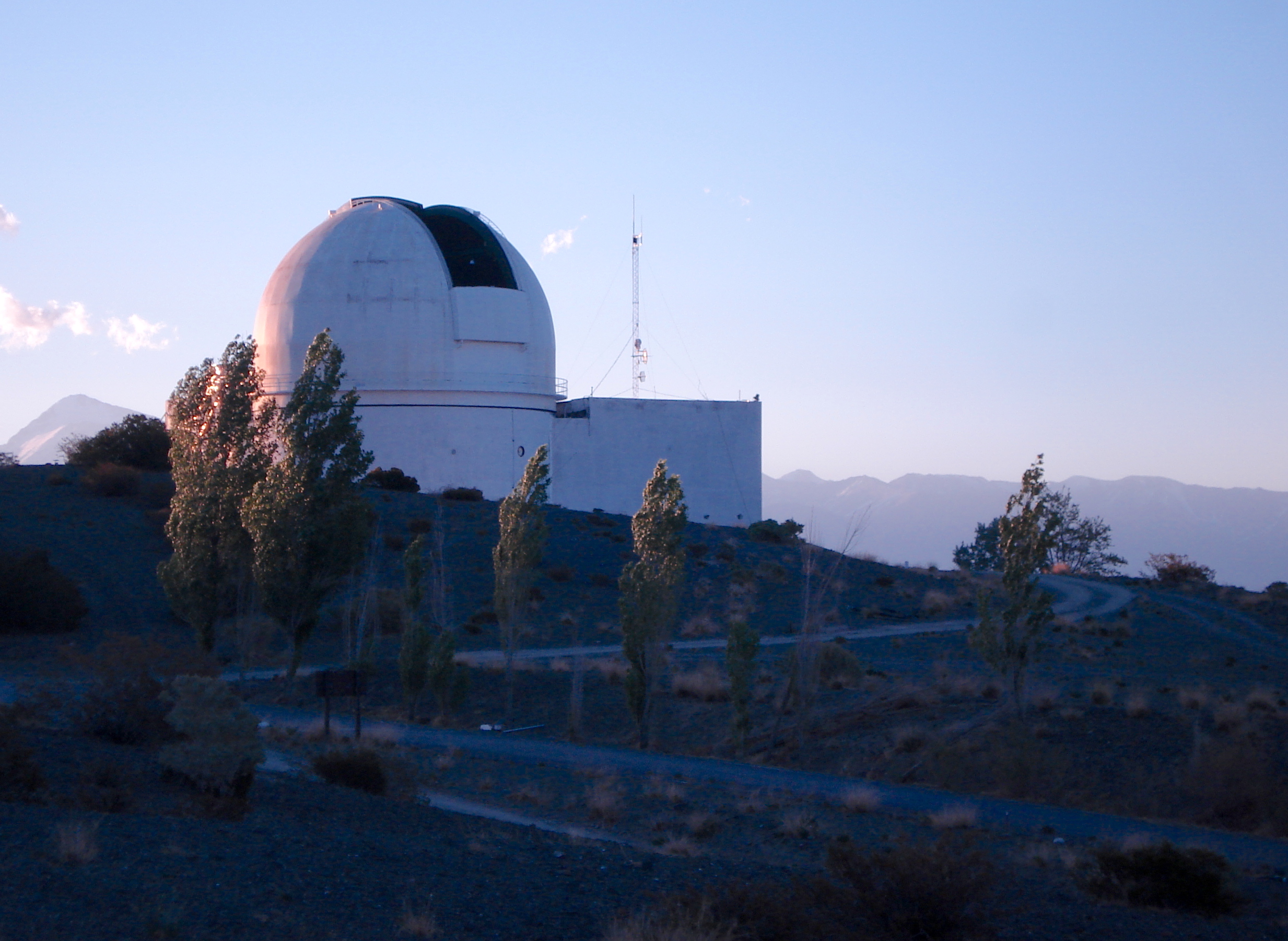
CASLEO observatory in springtime (credit: Hugo Durantini Luca)
My trip to Salta and the OAT was the longest distance I have traveled and my longest stay away from home in a very long time, but a wonderful experience for multiple reasons. Not only I never visited before the north of my country, with a visit to the National University of Salta included, I was traveling to collaborate in the project of a new astronomical observatory that is starting to work at the same time that I keep my formation as Telescope Operator and advancing in my Astronomy career with help of exceptional people.
The trip to the OAT, located in the small town of Tolar Grande is, let’s say… a bit longer compared with the trip to CASLEO (1200 vs 750 kilometers), but the landscape alone makes the trip worthwhile. Even with the OAT in a stage of construction, we already were able to capture CCD images with enough quality to make a few first contributions: exoplanet transit reports and others events. The potential of the site is huge.
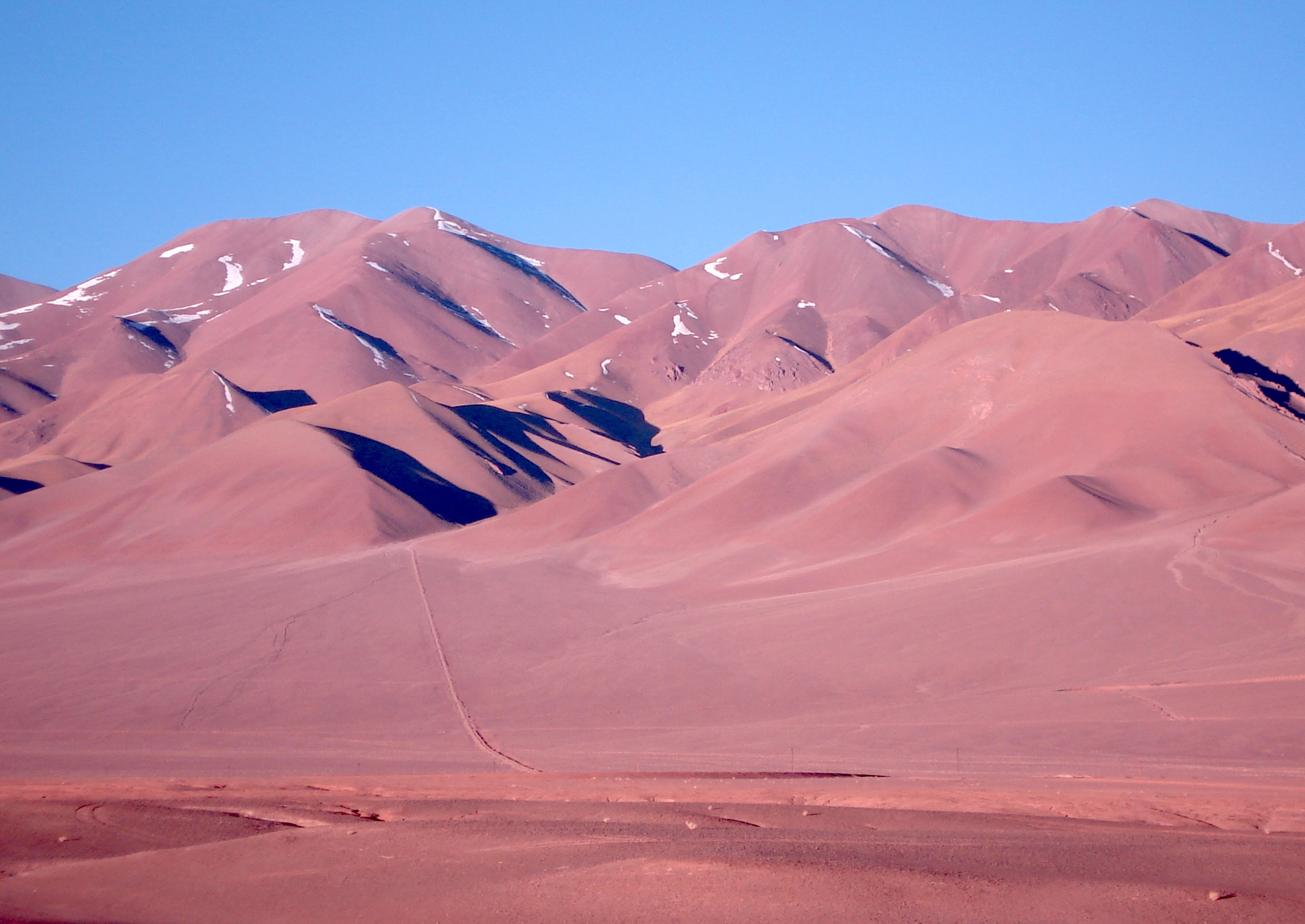
Macon mountain range outside Tolar Grande (credit: Hugo Durantini Luca)
Tolar Grande is a town with a bit more than 200 inhabitants, but the calm that possesses you along with an incomparable night sky that surpassed the experience of seeing for the first time the Milky Way at CASLEO.
Bosque Alegre (EABA) in Cordoba was another great experience this year, was able to interact with both telescopes while we were doing observations for the June transit of transneptunian object MU69. The 1.54 meter telescope is the same one that participated of the kilonova discovery that traveled the world with the news of the first gravitational wave event with a confirmed optical counterpart (is worth to mention that the OAT also tried to contributed there), but in this case I worked with the Perrine Telescope (76 cm).
I could keep writing pages upon pages describing in detail all the experiences, but that is not the idea of this post. The idea was to present a small summary of my experiences and current activities, whose initial seeds started in Disk Detective and then started to branch off in ways that I was unable to imagine. Citizen science is without a doubt an invaluable tool for common people to get involved with subjects what they love, maybe at first only like a hobby, maybe later like the start of a career in the scientific world.
Never stop chasing your dreams, and in the case of Astronomy, looking to the skies!
With thanks to Marc Kuchner, Steven Silverberg, Alissa Bans and Milton Bosch from Disk Detective, to the people of the Space Telescope Science Institute–Bernie Shiao, John Debes and Geoff Wallace–and the people of the OAC / GAF / IATE–Diego García Lambas, Carlos Colazo, Matías Schneiter, Cecilia Quiñones, Rodolfo Artola, Carla Girardini, Raul Melia and others. Without them I would not be writing these words, with so many projects in my mind that I hope to get done.
–Hugo

Dome to be installed in the Astronomical Observatory of Tolar / Observatorio Astrómico Tolar (OAT) credit: Hugo Durantini Luca
Odds and Ends
Howdy Disk Detectives,
Just thought I’d give you an update on some goings on since our last blog post.
First of all—the project is now 59% complete! That’s fantastic. Keep up the good work, everybody! The James Webb Space Telescope is set to launch next fall, and start taking science data in the spring of 2019. Let’s try to finish up all the classification work by then! I bet we can.

Disk Detective Milton Bosch visits NASA Headquarters.
Second of all, Goddard Space Flight Center held a “Citizen Science/Crowdsourcing Week” this summer, and Disk Detective’s own Dr. Milton Bosch came out to participate. Milton also spent a day visiting NASA headquarters, talking to scientists and managers about how citizen science can help NASA. The goal of the week was to encourage more scientists at Goddard and the rest of NASA to launch citizen projects and use crowdsourcing in their research. It was a huge success! There were nine talks on citizen science and crowdsourcing, and Milton met with 16 different scientists from all our scientific divisions at Goddard. We are planning to do it again next year; let us know if you might want to come down to Greenbelt, MD and participate!
Third of all, I can report that our ALMA proposal did not get selected. But it was a near miss–and we are going to try again! We submitted a proposal called “Sub-millimeter Observations of Long-lived Accretion Disks'”asking to measure submillimeter radiation from dust around WISE J080822.18-644357.3, the record-breaking disk we discovered plus a few other similar object. The review panel ranked the proposal in the second quartile and gave us a few tips on how to improve it for next round.
In other news, a handy new catalog of disks has appeared online: CircumstellarDisks.org. This catalog shows what we dream of at Disk Detective: disks that have been “resolved” by telescopes. “Resolved” means that an image of the disk shows more than a dot of light; it actually has the shape of a disk, maybe even a disk with some structure. Anyway, if you want to see some of the awesome images that keep us disk researchers motivated, take a peek at CircumstellarDisks.org.
Behind the scenes, the science team is busy working on papers about our follow-up observations from the FAST spectrograph, Robo AO, and the duPont telescope. The advanced users group is vetting objects of interest for future proposals and looking for new moving groups. And we’re finding lots of interesting disks!
Stay tuned for more news—and keep up the good searching!
Marc Kuchner
Some Housekeeping, and My Trip on SOFIA
Hi, all. Steven Silverberg from the science team here. Rather than my blog posts appearing under Marc’s name, I’ll be writing on this name from now on. It should make the blog a bit easier and less confusing to read.
Two weeks ago, I was lucky enough to observe on the Stratospheric Observatory For Infrared Astronomy (SOFIA). Here’s a summary of what we did, and what it was like.
SOFIA is a 747 with a custom hatch in the back and a telescope mounted inside, allowing us to observe from 40,000 feet. That altitude is above the primary part of the atmosphere that blocks infrared light, which means the telescope can observe at wavelengths longer than the ones we see in our Disk Detective WISE data, but shorter than the submillimeter wavelengths we’ve observed at with the James Clerk Maxwell Telescope. This neatly fills in a gap in our SEDs, giving us a clearer picture of how dust is distributed in these systems.
Last SOFIA proposal cycle, we submitted two proposals, and one was accepted for “do if time” status. This proposal was to get 53 micron data on a set of our main sequence A stars, as well as those identified by other projects (such as Patel et al. 2014). Our first set of observations was scheduled for May 9-11, so John Debes from the science team (and Space Telescope Science Institute) and I flew to California to ride along.
The plane itself is pretty impressive. 747s are big.
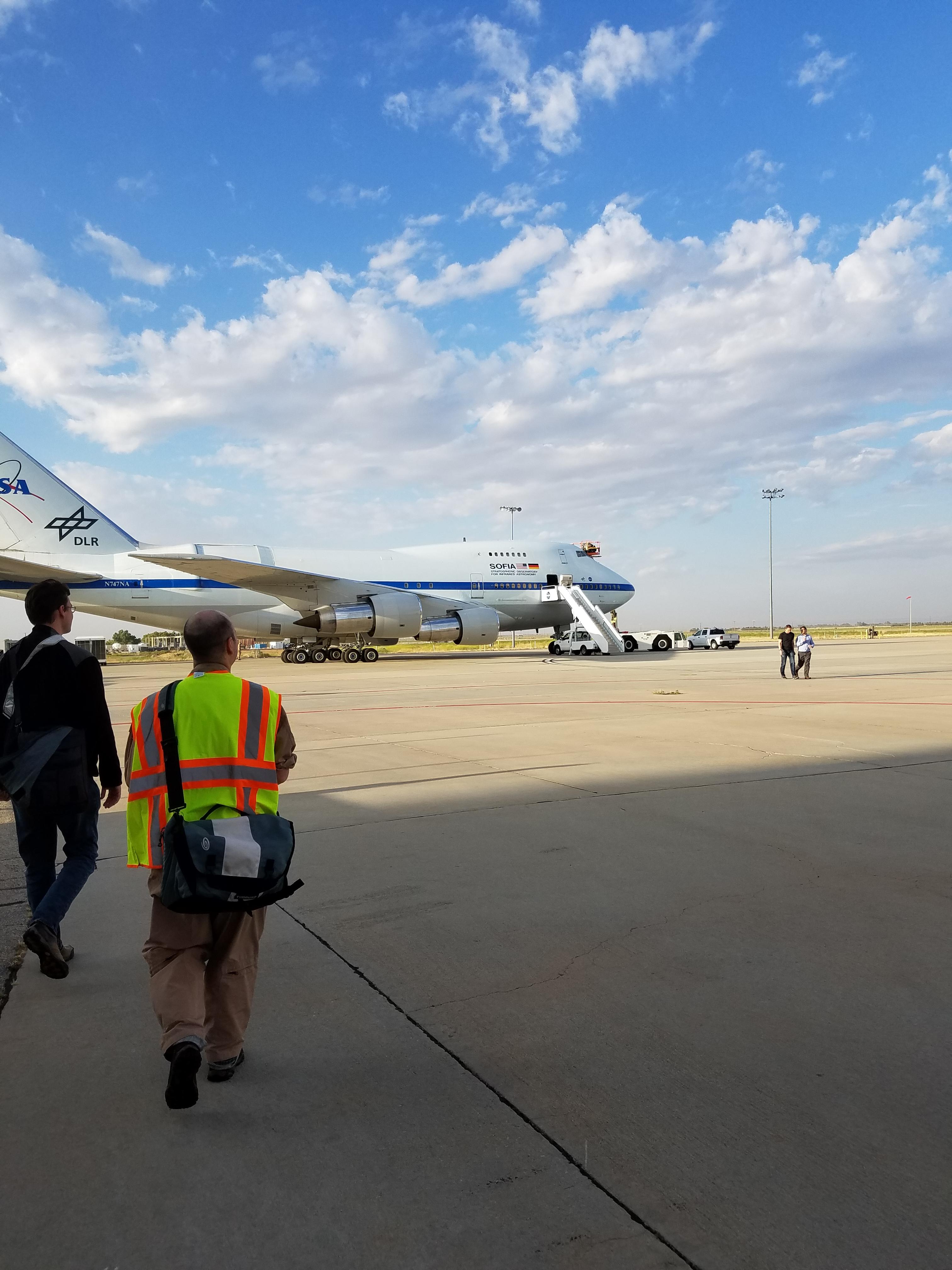
SOFIA is a working plane, so everyone onboard is piped in to the comms system. Wearing a flight comms headset makes you look important.

Because they had space, I was given permission to ride along in the cockpit for takeoff. Unfortunately, our first flight had to be scrubbed before takeoff, due to issues with some of the engine gauges.
I did, however, get to ride in the cockpit for takeoff on the second night. Sunset is really pretty when looking through the windshield of a 747.
The main cabin of SOFIA feels a little bit like mission control; lots of people looking at lots of monitors, all in rows. On these flights, we had SOFIA flight safety crew, the mission directors, telescope operators, and the team that built the HAWC+ instrument we were using.

We proposed to look at objects with an instrument called HAWC+ (High-resolution Airborne Wideband Camera-plus). This is a far-infrared camera, designed to probe long wavelengths. If the detector is sensitive enough and our target bright enough, we would be able to see light from our star+disk systems to add another point to our SED for that DDOI, but at worst we can get upper limits on what flux there is, letting us at least constrain the system.
HAWC+ has to come into the cabin through the main doors of the airplane. It’s engineered to fit through with 1/8 of an inch of clearance on either side.

SOFIA helpfully has lots of posters along the bulkhead about how it works…
…and some of the science it does

It also has one about how NASA came to acquire the plane.
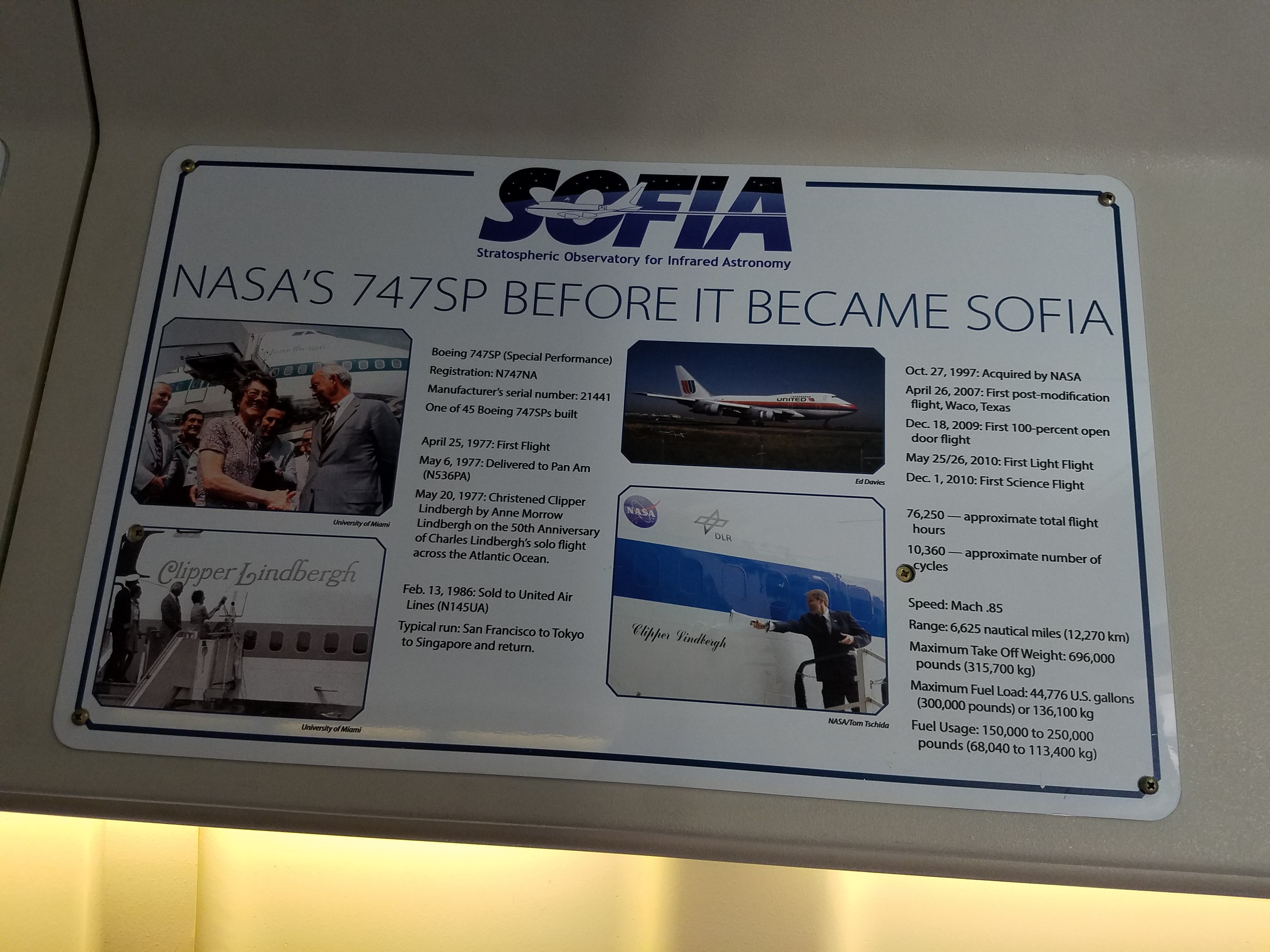
Sunsets were impressive through the regular windows, too.
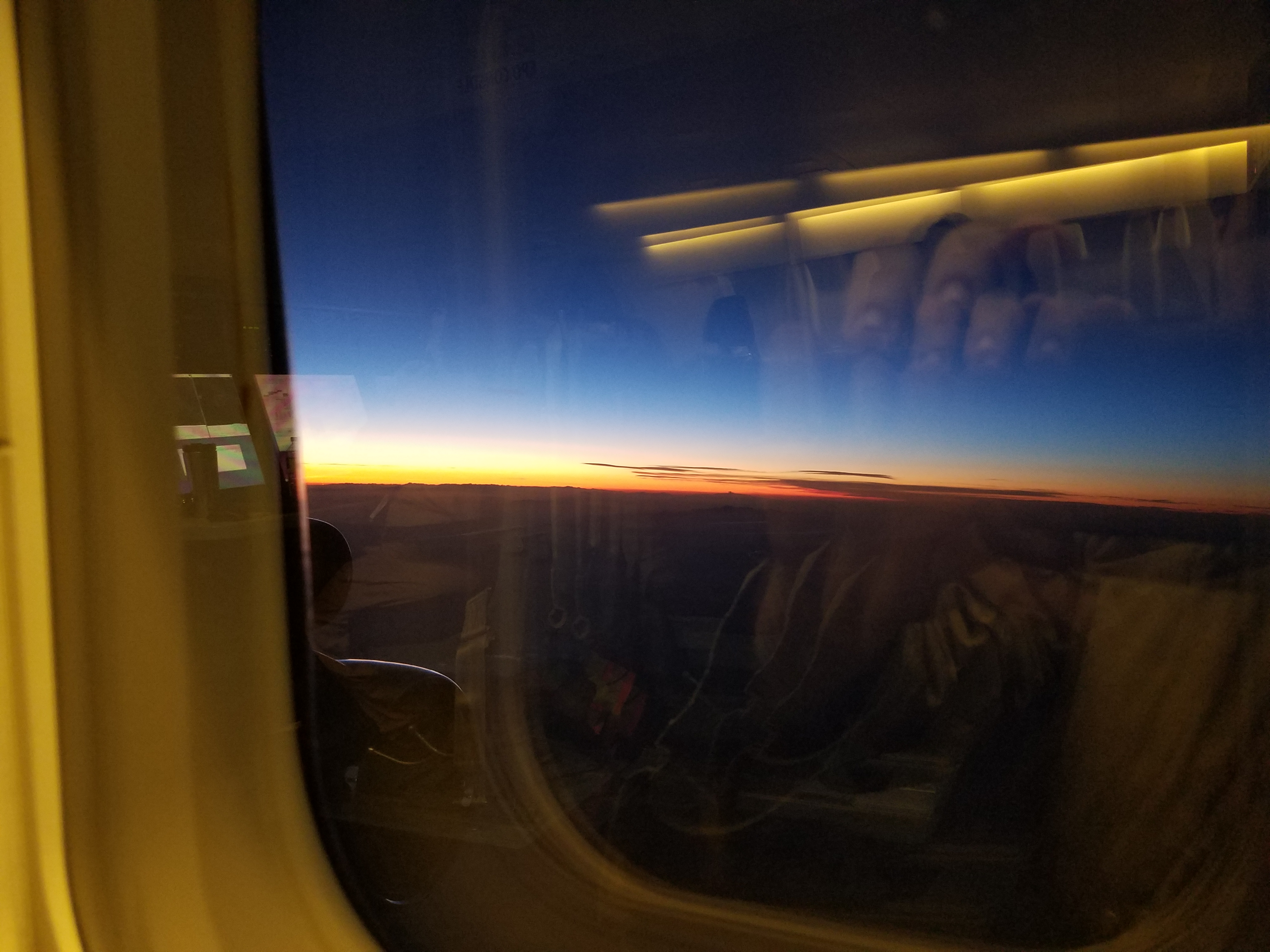
So was the Moon on our second flight.

Our last flight lasted long enough that the Sun was rising as we went into our descent.

The hangar the program is based out of is (unsurprisingly) huge.

All in all, it was a very educational, very informative, very fun trip on SOFIA. Thanks to you all for contributing to this project to make things like getting data from it feasible.














